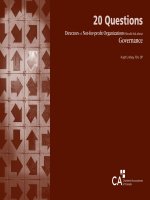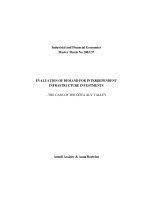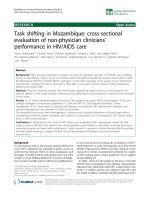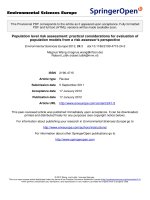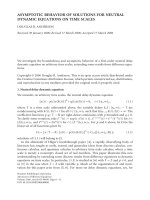Electrochemical evaluation of additives for lead–acid batteries under high-discharge conditions pdf
Bạn đang xem bản rút gọn của tài liệu. Xem và tải ngay bản đầy đủ của tài liệu tại đây (260.6 KB, 5 trang )
Ž.
Journal of Power Sources 78 1999 30–34
Electrochemical evaluation of additives for lead–acid batteries under
high-discharge conditions
R. Flores
a,)
, L.M. Blanco
b
a
Acumuladores Mexicanos, S.A. de C.V., AÕe Eugenio Garza Sada 3431 Sur, Monterrey, 64740, NueÕo Leon, Mexico
´
b
Facultad de Ciencias Quımicas, UANL, Cd. UniÕersitaria, San Nicolas de los Garza, 66450, NueÕo Leon, Mexico
´´´
Received 31 July 1998; accepted 15 November 1998
Abstract
Organic expanders play an important role in the lead–acid battery. This study presents the design of an electrochemical method which
evaluates the influence of some commercial expanders on the performance of the negative plate. Examination is made of different
commercial expander formulations which are prepared in the laboratory under carefully controlled conditions. In order to compare their
influence on the behaviour of the negative plate, potential step and cyclic voltammetric techniques using high-potential polarization are
performed. The results allow the selection of those expander additives which exert the best electrochemical effect on high-rate discharge
reactions at negative plates. q 1999 Elsevier Science S.A. All rights reserved.
Keywords: Charge–discharge cycles; Expanders; Electrochemical evaluation; Lead–acid battery; Negative active-material
1. Introduction
The economics of lead–acid batteries have led to the
search for a rapid and reliable method for the evaluation of
the additives which are required in the negative plates of
these batteries. The additives are called ‘expanders’ and
their mechanism of action has been studied in detail by
wx
Pavlov 1 . It has been found that expanders of the ligno-
sulfonate type are strongly adsorbed on the lead surface,
and during lead dissolution the Pb
2q
ions migrate through
the adsorbed layer. This adsorption of the expander affects
wx
the anodic oxidation of Pb 2 , the cathodic reduction of
wx
lead sulfate 3 , the morphology of lead sulfate, and both
the porosity and the surface area of the negative-plate
wx
material 4,5 . In particular, the presence of an expander
restricts the crystal growth of the porous lead active mate-
rial and, thereby, increases the active surface area of the
wx
negative plate 6,7 . The resulting small crystals are con-
wx
sumed during discharge and reformed during recharge 8 .
The change in the porous structure of the plate due to
expander adsorption reduces polarization during discharge,
and improves negative-plate behaviour under high-current
)
Corresponding author
discharge both at low temperatures and at high acid con-
centrations. In addition, expanders affect the hydrogen
overpotential with consequent discharge inhibition.
The oxidation of lead to PbSO is a dissolution–precipi-
4
tation process which is controlled by the diffusion of Pb
2q
wx
ions through the perm-selective PbSO layer 9 . Micro-
4
scopic analysis suggests that electrochemical oxidation of
lead in the presence of an expander produces a more
porous PbSO layer with greater ionic permeability. Con-
4
sequently, the diffusion of Pb
2q
ions through such layer is
wx
favoured, as is the process of metal oxidation. Mahato 10
Ž.
has suggested the possible formation of a Pb II –lignin
complex, which ultimately causes precipitation of PbSO ,
4
and which increases the porosity of the solid membrane.
The formation of such a complex implies the need to apply
a greater overpotential in the presence of an expander to
reduce PbSO to lead. Mahato also employed cyclic
4
Ž.
voltammetry CV to evaluate the influence of expanders
on the behaviour of the negative electrode, and to demon-
strate this influence after a given number of cycles with
respect to initial capacity and electrode discharge reac-
tions.
The use of an electrochemical technique to examine and
explain the influence of an expander on the potential
0378-7753r99r$ - see front matter q 1999 Elsevier Science S.A. All rights reserved.
Ž.
PII: S0378-7753 99 00007-5
()
R. Flores, L.M. BlancorJournal of Power Sources 78 1999 30–34 31
dynamic response of a lead–acid battery negative plate has
wx
been reported by Saakes et al. 11 . Saakes and van Duin
wx
12 also developed a technique to select suitable ex-
panders and inhibitors. This was based on potential-sweep
measurements and galvanostatic impedance techniques, and
it was shown that determination of impedance at constant
current improves significantly the understanding of the
physical process which takes place during discharge of a
negative plate and, thereby, permits adequate selection of
wx
the best additive. Meanwhile, Hall and Wright 13 per-
formed potential-step experiments to study the formation
of PbSO in H SO at y188C, ‘with’ and ‘without’
424
expanders, and proposed a mechanism of expander action
for the charge-transfer process. Finally, there have been
wx
several other investigations 14–16 in which potential-
sweep methods have been employed to explain the influ-
ence of different expanders on the discharge capacity of
the negative plate.
The scaling-up of results obtained by the above tech-
niques is not always reliable because it does not consider
the effect of scaling-up itself or a possible synergy among
the components of the expander formulation. Data from
small-electrode studies can change when scaled-up to the
negative plates of a battery, and thus realistic conclusions
can only be drawn by conducting experiments on plates
themselves.
To date, there has been no methodology to allow prese-
lection of possible additives that takes into account all the
effects of expanders and that also allows reliable scale-up
to production levels. Accordingly, this work presents a
simple electrochemical method, which combines the tech-
Ž.
niques of CV and chronocoulometry CC , to provide rapid
selection of the expander with the best impact on
negative-plate performance. The laboratory procedure
demonstrates high reliability in scaling-up to production
levels.
2. Experimental
The expander formulations are listed in Table 1. Their
efficiency and performance were tested and compared by
Ž
2
means of CV and CC. A miniplate area: 4.6 cm ; thick-
.
ness 1.3–1.5 mm with 2.4 g of active material was used
as the working electrode. The grid alloy was lead–calcium.
Table 1
Expander compositions
Compound BaSO Carbon Lignin
4
Ž.
Range wt.% 1.0–0.2 0.30–0.15 0.4–0.15
A Low Low Low
B High Medium High
C Medium High High
D High Medium High
E Medium High Medium
Table 2
Paste formula
Ž.
Lead oxide g 100
Ž.
Water g 14.3
Ž.
Sulfuric acid, 1.400 relative density g 12.3
Ž.
Fibre g 0.1
Expander according to formula
In CV testing, three series of 50 cycles were performed
between y1.250 and y0.700 V at a sweep speed of 20
mV s
y1
.
All the tests were conducted at room temperature using
a Potentiostat–Galvanostat EG&G PAR 273A fitted with
an Options 92r96, EG&G Interface Power Booster, and a
KEPCO Bioperational Amplifier model BOP 20-20M. This
equipment allows studies up to 20 A and 20 V.
The paste formulation is given in Table 2. After curing
and drying, formation was carried out in 3.15 M H SO
24
with a current density of 3.25 mA cm
y2
at 0.3 A h g
y1
.A
final charge at 3.25 mA cm
y2
for 4 h was applied in 4.7
M H SO .
24
The experimental cell had a capacity of 2 l and con-
tained the working electrode, two auxiliary PbO elec-
2
Ž
2
.
trodes each with an area of 174 cm , and a HgrHgSO ,
4
SO
2y
reference electrode. After each discharge, complete
4
recharge of the miniplate was achieved by applying a
constant current of 3.25 mA cm
y2
to 130% overcharge in
4.7 M H SO .
24
The percentage utilization of negative active-material
Ž.
NAM was taken as a measure of the effect of a given
expander on the negative-plate capacity for a given num-
ber of cycles. Cycling was continued until physical evi-
dence of plate damage was observed, such as active mate-
rial shedding or blisters on the surface.
3. Results and discussion
In chronocoulometric studies with a single potential
step, measurements were made of the quantity of charge
Fig. 1. Discharge transients of expander B under high polarization.
()
R. Flores, L.M. BlancorJournal of Power Sources 78 1999 30–3432
Table 3
Percent NAM utilization in CC single-potential step
Expander Cycle
12345678910111213
A 24.20 22.77 22.58 18.40 21.65 14.94 15.34
B 11.50 12.47 12.20 9.92 12.15 13.52 12.31 12.58 13.34 10.82
C 14.20 9.64 11.18 8.71 7.72 7.38 7.45 6.79 6.77 6.49 6.63
D 25.70 26.02 26.41 26.75 19.20 20.31 19.37 17.41 15.97 15.23 14.78 10.94 13.62
E 22.62 23.22 22.02 22.31 21.18 19.66 18.55 16.57 16.07 14.72 15.37
Fig. 2. Charge transient of expander B after high-polarization discharge.
which each plate with expander was able to produce
during three successive discharges for 30 s, with a 30-min
rest and no recharge between them, and when a potential
step of 1.750 V was applied. The results for one type of
Ž.
expander expander B are presented in Fig. 1, and Table 3
summarizes the utilization of NAM for all the expanders.
Once a plate was discharged, a potential of y1.350 V was
applied for 360 s and the quantity of charge accepted was
measured. The charge transient for expander B is shown in
Fig. 2. The utilization of NAM in three successive dis-
charges under high polarization as a function of cycle
number is listed in Table 3 for five expanders. The data
reveal that increase in the number of discharges reduces
the quantity of charge that a plate can deliver. Also, it is
obvious that the best expander is D because it exhibits the
highest utilization of NAM and withstands the greatest
Fig. 3. Cycling effect on NAM utilization during test 1 of expander B.
Fig. 4. Differences between expanders on test 1 at cycle 20.
number of cycles. By contrast, expander C displays the
Ž.
best recharging behaviour Table 4 , a finding which agrees
with CV studies. These results are in accordance with the
Table 4
Ž.
Percent of charge recovery Q rQ = 100
cd
Expander Cycle
1 2 3 4 5 6 7 8 9 10 11 12 13
A 18.77 23.12 23.52 29.41 28.09 27.78 45.07
B 21.36 29.3 27.46 32.74 28.35 27.54 30.13 34.2 26.85
C 85.81 106.9 97.22 98.54 107.84 98.72 102.55 108.81 109.09 106.24 103.46
D 17.43 23.83 17.87 20.15 21.33 29.22 25.84 25.81 31.09 36.02 44.44 49.68 38.75
E 56.56 59.4 69.58 70.77 75.19 75.32 71.82 78.04 81.22 84.38 89.5
()
R. Flores, L.M. BlancorJournal of Power Sources 78 1999 30–34 33
Table 5
Percent NAM utilization during first and third test discharges in 50-cycle
sequence
Cycle Test Expander
ABCDE
1 1 2.29 1.48 2.59 1.55 2.06
3 2.59 1.79 2.77 2.12 3.32
5 1 1.20 1.10 2.75 1.35 1.65
3 1.44 1.45 2.86 1.80 2.93
10 1 0.59 0.72 2.83 1.14 1.61
3 0.74 0.87 2.95 1.47 2.89
16 1 0.51 0.39 2.85 0.94 1.61
3 0.53 0.48 3.04 1.17 2.86
20 1 0.52 0.29 2.93 0.78 1.62
3 0.53 0.40 3.08 0.97 2.91
50 1 0.61 0.15 3.02 0.21 1.85
3 0.67 0.34 3.20 0.32 3.24
observation that an expander which favours high discharge
also inhibits charge-acceptance.
Voltammograms reflect differences in behaviour of the
miniplates with different expanders before rechargingrdis-
charging and during cycling. The CV analysis was made in
terms of the quantity of charge that was obtained during
cycles 1, 5, 10, 16, 20 and 50, both during recharge and
discharge for the first and third test discharges. These
results are reported in Figs. 3 and 4, and in Table 5. It is
evident that expanders C and E display the best behaviour
because they permit the negative plate to use the highest
amount of NAM; the difference between them is quite
small. This can be explained by the ready recharge of
plates which contain these expanders; see Fig. 5.
The behaviour of all the expanders is given in Fig. 6 in
terms of the percentage variation in the utilization of NAM
during discharge between the first and third CV experi-
ments at 20 mV s
y1
for the selected cycles. The results
demonstrate that expander E is the additive which experi-
ences the greatest variation in NAM utilization. This ex-
pander promotes an increase in the volume of active
material which, in turn, increases the reactive area of the
negative plates. In effect, the plates become ‘spongier’.
This was confirmed by physical inspection: the plates
developed blisters during cycling in the presence of the
expander.
4. Conclusions
The proposed electrochemical method, which consists
of applying a combination of potential-step and potential-
sweep techniques, offers a rapid and simple means to
differentiate the impact of expanders on the performance
of negative plates in lead–acid batteries. The resulting
discharge and recharge transients show the effect of the
expander on the electrode response under the current de-
mand and charge-acceptance required during cycling.
The use of a miniplate as the electrode, and evaluation
of the results in terms of the percentage utilization of
NAM, provide a reliable method for selecting the most
adequate expander before producing battery prototypes.
In future work, similar experiments will be performed
at 40, 70, 0 and y188C in order to determine the chemical
Fig. 5. Percent NAM utilization during discharge.
()
R. Flores, L.M. BlancorJournal of Power Sources 78 1999 30–3434
Fig. 6. Percent variation of NAM utilization between first and third series of cycles.
stability of the lignin component of the separator at differ-
ent temperatures.
Acknowledgements
The authors are grateful to Francisco Gonzalez, San-
´
juana Garza, Romeo Rodrıguez, Oziel Rodrıguez and Paola
´´
Cavazos for both the chemical analysis and their support in
the experimental part of this work. This study is part of an
ENERMEX research project.
References
wx Ž.
1 D. Pavlov, in: B.D. McNicol, D.A.J. Rand Eds. , Power Sources for
Electric Vehicles, Elsevier, Amsterdam, 1984, p. 11.
wx Ž.
2 M.P.J. Brennan, N.A. Hampson, J. Electroanal. Chem. 48 1973
465.
wx Ž.
3 M.P.J. Brennan, N.A. Hampson, J. Electroanal. Chem. 52 1974 1.
wx Ž.
4 N.A. Hampson, J.B. Lakeman, J. Electroanal. Chem. 119 1981 3.
wx
5 J.R. Pierson, P. Gurlusky, A.C. Simon, S.M. Caulder, J. Elec-
Ž.
trochem. Soc. 117 1970 1463.
wx Ž.
6 B.K. Mahato, J. Electrochem. Soc. 124 1977 1663.
wx Ž.
7 N.A. Hampson, J.B. Lakeman, J. Power Sources 6 1981 101.
wx
8 D. Pavlov, E. Bashtavelova, V. Iliev, in: K.R. Bullock, D. Pavlov
Ž.
Eds. , Advances in Lead–Acid Batteries, The Electrochemical Soci-
ety, Pennington, NJ, 1984, p. 16.
wx Ž.
9 K. Das, K. Bose, Bull. Electrochem. 2 1986 .
wx Ž.
10 B.K. Mahato, J. Electrochem. Soc. 127 1980 1679.
wx
11 M. Saakes, P.J. van Duin, A.C.P. Ligtvoet, D. Schmal, J. Power
Ž.
Sources 32 1991 25.
wx
12 M. Saakes, P.A. van Duin, 41st Meeting ISE, Czechoslovakia, 1990.
wx Ž.
13 S.B. Hall, G.A. Wright, J. Power Sources 30 1990 193.
wx
14 T. Mohammadi, V.S. Donepudi, M. Girgis, W.A. Adams, J. Power
Ž.
Sources 40 1992 323.
wx Ž.
15 P.J. Mitchel, N.A. Hampson, J. Power Sources 8 1982 197.
wx Ž.Ž .
16 M. Kosai et al., G.S. News Tech. Rep. 51 2 1992 6.
